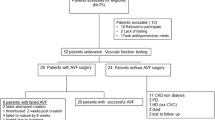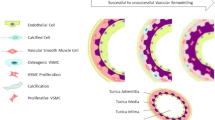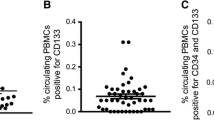Abstract
Aims
Arteriovenous fistula (AVF) failure is one of the most important clinical problems in end-stage renal disease. Endothelial progenitor cells (EPCs) have a role on vascular angiogenesis and endothelialization. We aimed to investigate the association markers of EPCs on AVF maturation by measuring the surface expressions of CD34, CD309 and CD133 on the monocytes.
Methods
This prospective observational study was conducted in 54 voluntary patients with end-stage renal disease who were admitted for their first renal replacement therapy and were available for AVF creation. Venography was performed in all patients before AVF creation. Six patients were excluded due to inadequate veins after venographic imaging, and also seven patients were excluded due to postoperative thrombosis. The blood samples were analyzed a day before the fistula operation, and the expressions of CD34, CD133 and CD309 on the surface of monocytes were measured.
Results
Patients were divided into two groups after the evaluation of AVF maturation, as the mature group and the failure group. The CD309 expression level on the monocytes was 338.00 (35.00–479.00) in the mature group; however, it was 36.00 (5.50–237.00) (p 0.031) in the failure group. Multiple logistic regression analyses showed that both BMI and the mean fluorescence intensity level of CD309 expression on monocytes independently predicted AVF maturation.
Conclusions
The presence of DM and increased BMI negatively correlated with AVF maturation. High intensity of CD309 expression on monocytes was observed in patients with successful AVF maturation.



Similar content being viewed by others

References
Feldman HI, Kobrin S, Wasserstein A (1996) Hemodialysis vascular access morbidity. J Am Soc Nephrol 7:523–535
Allon M, Robbin ML (2002) Increasing arteriovenous fistulas in hemodialysis patients: problems and solutions. Kidney Int 62:1109–1124
Dixon BS, Novak L, Fangman J (2002) Hemodialysis vascular access survival: upper-arm native arteriovenous fistula. Am J Kidney Dis 39:92–101
NKF-K/DOQI Clinical Practice Guidelines For Vascular Access: Update 2006. Guideline 8: Clinical outcome goals, 8.1 goals for access placement, 8.1.2 prevalent functional AVF placement rate
Allon M, Ornt DB, Schwab SJ, Rasmussen C, Delmez JA, Greene T, Kusek JW, Martin AA, Minda S (2000) Factors associated with the prevalence of arteriovenous fistulas in hemodialysis patients in the HEMO study. Hemodialysis (HEMO) Study Group. Kidney Int 58(5):2178–2185
Lok CE, Allon M, Moist L, Oliver MJ, Shah H, Zimmerman D (2006) Risk equation determining unsuccessful cannulation events and failure to maturation in arteriovenous fistulas (REDUCE FTM I). J Am Soc Nephrol 17(11):3204–3212
Roy-Chaudhury P, Spergel LM, Besarab A, Asif A, Ravani P (2007) Biology of arteriovenous fistula failure. J Nephrol 20(2):150–163
Kong D, Melo LG, Gnecchi M, Zhang L, Mostoslavsky G, Liew CC, Pratt RE, Dzau VJ (2004) Cytokine-induced mobilization of circulating endothelial progenitor cells enhances repair of injured arteries. Circulation 110(14):2039–2046
Rohde E, Malischnik C, Thaler D, Maierhofer T, Linkesch W, Lanzer G, Guelly C, Strunk D (2006) Blood monocytes mimic endothelial progenitor cells. Stem Cells 24(2):357–367
Szmitko PE, Fedak PW, Weisel RD, Stewart DJ, Kutryk MJ, Verma S (2003) Endothelial progenitor cells: new hope for a broken heart. Circulation 107(24):3093–3100
Robbin ML, Chamberlain NE, Lockhart ME, Gallichio MH, Young CJ, Deierhoi MH, Allon M (2002) Hemodialysis arteriovenous fistula maturity: US evaluation. Radiology 225(1):59–64
Lee T, Mokrzycki M, Moist L, Maya I, Vazquez M, Lok CE (2011) North American Vascular Access Consortium. Standardized definitions for hemodialysis vascular access. Semin Dial 24(5):515–524
Mihmanli I, Besirli K, Kurugoglu S, Atakir K, Haider S, Ogut G, Numan F, Canturk E, Sayin AG (2001) Cephalic vein and hemodialysis fistula: surgeon’s observation versus color Doppler ultrasonographic findings. J Ultrasound Med 20(3):217–222
Patel ST, Hughes J, Mills JL Sr (2003) Failure of arteriovenous fistula maturation: an unintended consequence of exceeding dialysis outcome quality Initiative guidelines for hemodialysis access. J Vasc Surg 38(3):439–445
Ferring M, Henderson J, Wilmink A, Smith S (2008) Vascular ultrasound for the pre-operative evaluation prior to arteriovenous fistula formation for haemodialysis: review of the evidence. Nephrol Dial Transpl 23(6):1809–1815
Ilhan G, Esi E, Bozok S, Yürekli I, Özpak B, Özelçi A, Destan B, Gürbüz A (2013) The clinical utility of vascular mapping with Doppler ultrasound prior to arteriovenous fistula construction for hemodialysis access. J Vasc Access 14(1):83–88
Hyland K, Cohen RM, Kwak A, Shlansky-Goldberg RD, Soulen MC, Patel AA, Mondschein JI, Solomon JA, Stavropoulos SW, Itkin M, Yeh H, Markmann J, Trerotola SO (2008) Preoperative mapping venography in patients who require hemodialysis access: imaging findings and contribution to management. J Vasc Interv Radiol 19(7):1027–1033
Elsharawy MA, Moghazy KM (2006) Impact of pre-operative venography on the planning and outcome of vascular access for hemodialysis patients. J Vasc Access 7:123–128
Basile C, Lomonte C (2007) The operating surgeon is the major determinant for a successful arteriovenous fistula maturation. Kidney Int 72:772
Saucy F, Haesler E, Haller C, Déglise S, Teta D, Corpataux JM (2010) Is intra-operative blood flow predictive for early failure of radiocephalic arteriovenous fistula? Nephrol Dial Transpl 25(3):862–867
Krishnamoorthy MK, Banerjee RK, Wang Y, Choe AK, Rigger D, Roy-Chaudhury P (2012) Anatomic configuration affect flow rate and diameter of porcine arteriovenous fistulae. Kidney Int 81(8):745–750
Choi SJ, Yoon HE, Kim YS, Yoon SA, Yang CW, Kim YS, Park SC, Kim YO (2015) Pre-existing arterial micro-calcification predicts primary unassisted arteriovenous fistula failure in incident hemodialysis patients. Semin Dial 28(6):665–669
Jankovic A, Damjanovic T, Djuric Z, Marinkovic J, Schlieper G, Tosic-Dragovic J, Djuric P, Popovic J, Floege J, Dimkovic N (2015) Impact of vascular calcifications on arteriovenous fistula survival in hemodialysis patients: a five-year follow-up. Nephron 129(4):247–252
Allon M, Robbin ML, Umphrey HR, Young CJ, Deierhoi MH, Goodman J, Hanaway M, Lockhart ME, Barker-Finkel J, Litovsky S (2015) Preoperative arterial microcalcification and clinical outcomes of arteriovenous fistulas for hemodialysis. Am J Kidney Dis 66(1):84–90
Allon M, Robbin ML, Young CJ, Deierhoi MH, Goodman J, Hanaway M, Lockhart ME, Litovsky S (2013) Preoperative venous intimal hyperplasia, postoperative arteriovenous fistula stenosis, and clinical fistula outcomes. Clin J Am Soc Nephrol 8(10):1750–1755
Spergel LM, Ravani P, Roy-Chaudhury P, Asif A, Besarab A (2007) Surgical salvage of the autogenous arteriovenous fistula (AVF). J Nephrol 20(4):388–398
Silbernagel G, Rein P, Saely CH, Engelberger RP, Willenberg T, Do DD, Kucher N, Baumgartner I, Drexel H (2015) Prevalence of type 2 diabetes is higher in peripheral artery disease than in coronary artery disease patients. Diab Vasc Dis Res 12(2):146–149
Bonucchi D, Cappelli G, Albertazzi A (2002) Which is the preferred vascular access in diabetic patients? A view from Europe. Nephrol Dial Transpl 17:20–22
Murphy GJ, Nicholson ML (2002) Autogeneous elbow fistulas: the effect of diabetes mellitus on maturation, patency, and complication rates. Eur J Vasc Endovasc Surg 23:452–457
Lin SL, Huang CH, Chen HS, Hsu WA, Yen CJ, Yen TS (1998) Effects of age and diabetes on blood flow rate and primary outcome of newly created hemodialysis arteriovenous fistulas. Am J Nephrol 18(2):96–100
Sedlacek M, Teodorescu V, Falk A, Vassalotti JA, Uribarri J (2001) Hemodialysis access placement with preoperative noninvasive vascular mapping: comparison between patients with and without diabetes. Am J Kidney Dis 38(3):560–564
Plumb TJ, Adelson AB, Groggel GC, Johanning JM, Lynch TG, Lund B (2007) Obesity and hemodialysis vascular access failure. Am J Kidney Dis 50(3):450–454
Bourquelot P, Tawakol JB, Gaudric J, Natário A, Franco G, Turmel-Rodrigues L, Van Laere O, Raynaud A (2009) Lipectomy as a new approach to secondary procedure superficialization of direct autogenous forearm radial-cephalic arteriovenous accesses for hemodialysis. J Vasc Surg 50(2):369–374
Krochmal DJ, Rebecca AM, Kalkbrenner KA, Casey WJ, Fowl RJ, Stone WM, Chapital AB, Smith AA (2010) Superficialization of deep arteriovenous access procedures in obese patients using suction-assisted lipectomy: a novel approach. Can J Plast Surg 18(1):25–27
Chan MR, Young HN, Becker YT, Yevzlin AS (2008) Obesity as a predictor of vascular access outcomes: analysis of the USRDS DMMS Wave II study. Semin Dial 21:274–279
Diskin CJ, Stokes TJ, Thomas SG, Ravis W, Lock S, Thomas J, Panus LW, Dansby L, Carter T (1998) An analysis of the effect of routine medications on hemodialysis vascular access survival. Nephron 78(3):365–368
Saran R, Dykstra DM, Wolfe RA, Gillespie B, Held PJ, Young EW (2002) Dialysis Outcomes and Practice Patterns Study. Association between vascular access failure and the use of specific drugs: the Dialysis Outcomes and Practice Patterns Study (DOPPS). Am J Kidney Dis 40:1255
Andreucci VE, Fissell RB, Bragg-Gresham JL, Ethier J, Greenwood R, Pauly M, Wizemann V, Port FK (2004) Dialysis Outcomes and Practice Patterns Study (DOPPS) data on medications in hemodialysis patients. Am J Kidney Dis 44:61–67
Mattsson EJ, Kohler TR, Vergel SM, Clowes AW (1997) Increased blood flow induces regression of intimal hyperplasia. Arterioscler Thromb Vasc Biol 17(10):2245–2249
Guzman RJ, Abe K, Zarins CK (1997) Flow-induced arterial enlargement is inhibited by suppression of nitric oxide synthase activity in vivo. Surgery 122(2):273–279
Urbich C, Dimmeler S (2004) Endothelial progenitor cells: characterization and role in vascular biology. Circ Res 95(4):343–353
Asahara T, Murohara T, Sullivan A, Silver M, van der Zee R, Li T, Witzenbichler B, Schatteman G, Isner JM (1997) Isolation of putative progenitor endothelial cells for angiogenesis. Science 275(5302):964–967
Lin Y, Weisdorf DJ, Solovey A, Hebbel RP (2000) Origins of circulating endothelial cells and endothelial outgrowth from blood. J Clin Invest 105:71–77
Werner N, Junk S, Laufs U, Link A, Walenta K, Bohm M, Nickenig G (2003) Intravenous transfusion of endothelial progenitor cells reduces neointima formation after vascular injury. Circ Res 93(2):17–24
Griese DP, Ehsan A, Melo LG, Kong D, Zhang L, Mann MJ, Pratt RE, Mulligan RC, Dzau VJ (2003) Isolation and transplantation of autologous circulating endothelial cells into denuded vessels and prosthetic grafts: implications for cell-based vascular therapy. Circulation 108(21):2710–2715
Ozkok A, Aktas E, Yilmaz A, Telci A, Oflaz H, Deniz G, Yildiz A (2013) Decrease in endothelial progenitor cells associated with inflammation, but not with endothelial dysfunction in chronic hemodialysis patients. Clin Nephrol 79(1):21–30
Funding
This study was supported by the Erciyes University Council of Scientific Investigations (Project Code TTU-2013-4456).
Author information
Authors and Affiliations
Corresponding author
Ethics declarations
Conflict of interest
The authors declare that there is no conflict of interest.
Rights and permissions
About this article
Cite this article
Eroglu, E., Kocyigit, I., Saraymen, B. et al. The association of endothelial progenitor cell markers with arteriovenous fistula maturation in hemodialysis patients. Int Urol Nephrol 48, 891–899 (2016). https://doi.org/10.1007/s11255-016-1282-3
Received:
Accepted:
Published:
Issue Date:
DOI: https://doi.org/10.1007/s11255-016-1282-3



